Domaine Pierre Usseglio is on a Sensational Roll in Châteauneuf-du-Pape and Lirac + In-Store, Walk-Around Tasting With Grégory Usseglio
As a display of gratitude to those who have taken advantage of the many wine packages we have offered in the past, we invite you to an in-store experience, free of charge, to discover (and re-discover) one of our favorite Châteauneuf-du-Pape producers, Domaine Pierre Usseglio & Fils. It will also be an opportunity to purchase the wines at prices deeply discounted for the evening only.
Grégory Usseglio, grandson of the estate’s founder, will be on hand as host of a walk-around tasting on March 16, between 5PM and 7PM. We will feature wines from some of Usseglio’s most spectacular vintages of the past decade, and Gregory will share the winery’s unique vision; innovation steeped in tradition with a commitment to making Usseglio wines accessible to a wide range of palates.
Please call for an update on details and to reserve. Limited. (248) 398-0030
Meet Grégory Usseglio
There are many Usseglios to keep track of, although perhaps the correct Italian plural of the surname is ‘Ussegli’. Pierre Usseglio (of the eponymous Domaine) is not to be confused with his brother Raymond Usseglio, owner of a different winery. Domaine Pierre Usseglio was founded in 1948 by Francis Usseglio, who moved to Southern Rhône from Italy in 1931, and Pierre Usseglio’s children Jean-Pierre Usseglio and Thierry Usseglio have managed the Pierre Usseglio estate since 1999.
Now that you have them straight, we will introduce Grégory Usseglio, Jean-Pierre`s son, who becomes more involved in the domain with every vintage.
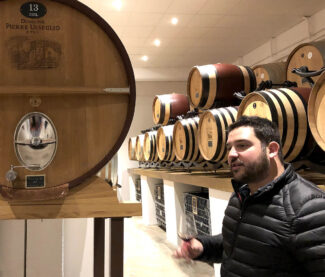
Grégory Usseglio
“One thing that has not changed,” says Grégory, “is our philosophy of tradition blended with innovation. In the late 1980s we began to isolate a small number of vines to make ‘Mon Aïeul’ and subsequently, to make a barrel selection, including some new oak, to make a prestige cuvée. There are other experiments going on, including some non-commercial cuvées. But really, heritage rules the roost here; all of our wines are pure and not dramatic or overdone. We remain true to the terroir of the commune, with vines planted throughout Châteauneuf. We enjoy the power of the south, while maintaining a light and elegant touch in the cellar.”
Domaine Pierre Usseglio & Fils
The quintessence of Châteauneuf-du-Pape is the conviction that the sum of parts is greater than the whole. As such, Domaine Pierre Usseglio maintains 60 acres of vines spread out across the entire region, maintaining property in 17 individual lieux-dits with one plot set aside for the production of white wine. The red-wine holdings are planted to 80% Grenache, 10% Syrah, 5% Mourvèdre, 5% Cinsault; vine age ranges from 30 to 75 years of age. A sizeable portion of the CdP vineyard sits within famous La Crau ancient confluence of the Durance and Rhône rivers; the rest climbs the hill across the road from the actual ruins of the castle from which Châteauneuf-du-Pape gets its name.
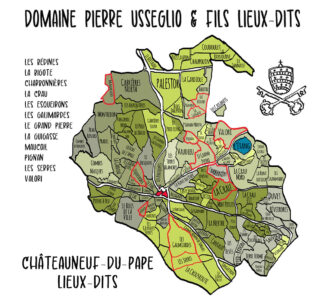
The estate also owns 15 acres of Côtes-du-Rhône, another 15 in Lirac and another five acres that it bottles as ‘Vin de France.’
Says Jean-Pierre: “We work our vineyard manually, and with respect throughout the seasons. We let nature express itself freely. It is thanks to this difference in terroir that we can offer complex, silky and balanced wines; our vines are spread across multiple sites where the soils range from limestone and rolled pebbles, to sand and sandstone flecked with clay. These are the voices of the earth and we are committed to listening.”
Châteauneuf-du-Pape
A Peak Expression of The Southern Rhône
Châteauneuf-du-Pape in France’s Rhône valley has traditionally been viewed as a rustic cousin to the elegant and long-lived persistence of great wines from Bordeaux. Châteauneuf is age-worthy, certainly, but there is exuberance in the fresh fruit flavors that dominate the style that makes it hedonistically drinkable virtually from the day it is released. It was said to make up for in pleasure what it lacked in sophistication.
With more than 8,000 acres under vine, Châteauneuf-du-Pape is the largest appellation in the Rhône, producing only two wines, red Châteauneuf-du-Pape, representing 94% of the appellation’s output, and white Châteauneuf-du-Pape. Of the eight red varietals planted, Grenache is the most dominant variety by far, taking up 80% of vineyard space, followed by Syrah, Mourvèdre and tiny quantities of Cinsault, Muscardin, Counoise, Vaccarèse and Terret Noir.
Terroir varies and can only be viewed as a generalization; limestone soil predominates in the western part of Châteauneuf-du-Pape; sand and clay soil covered with large stones on the plateaus. Mixed sand, red and grey clay, and limestone can be found in the northern part of the appellation, less stony soil alternating with marl in the east and shallow sand and clay soil on a well-drained layer of gravel in the south. The large pebbles contribute to the quality of the vines and grapes by storing heat during the day and holding water.
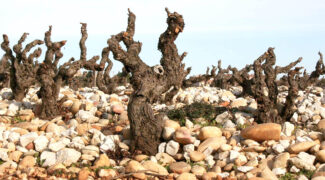
Untrained Old Vines Grenache Bush in Galets Roulés
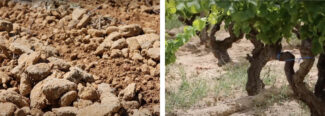
Grès Rouge, Sand and Safre
Like the soils, there is an enormous diversity of winemaking styles among these producers, creating both appealing, easy-to-understand fruit-filled wines as well as wines of greater intensity and sophistication.
A new generation of CdP is making wines that rival the depth of the best Bordeaux, offering a wide array of compelling aromatics, including Herbes de Provence, black cherry jam, black currants, blueberries, blackberries, roasted meats and even beef blood. These wines can be powerful, rich, full-bodied and concentrated enough to evolve for 15 to 25 years.
* Of the grapes that make up Usseglio’s Châteauneuf-du-Pape, Gregory Usseglio shares the following: “The Grenache comes from clay-rich soils in the Crau district; the Syrah comes from Cabrières; the Mourvèdre comes from a sandy lieu-dit called Valori just to the north of the appellation and the Cinsault and Clairette come from various plots composed of rolled pebbles, clay and sand. Grapes are harvested and selected manually with yields as low as 20-25hl/ha according to vintage conditions, mostly destemmed then fermented separately, and the wine is aged 12 months, half in oak foudre and half in concrete tank.”
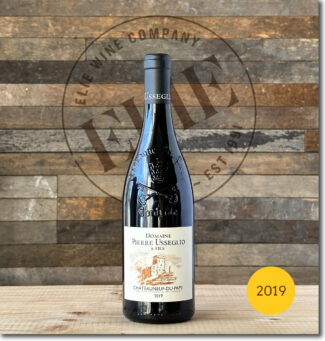 Domaine Pierre Usseglio & Fils ‘Cuvée Tradition’, 2019 Châteauneuf-du-Pape ($55)
Domaine Pierre Usseglio & Fils ‘Cuvée Tradition’, 2019 Châteauneuf-du-Pape ($55)
Primarily Grenache, with 15% each of Syrah and Mourvèdre and 10% Cinsault, showing cinnamon, strawberry and cocoa on the nose with a luscious palate filled with cassis, cherry compote and red licorice.
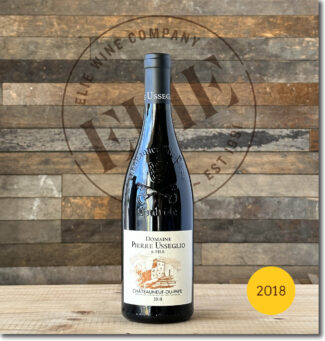 Domaine Pierre Usseglio & Fils ‘Cuvée Tradition’, 2018 Châteauneuf-du-Pape ($55)
Domaine Pierre Usseglio & Fils ‘Cuvée Tradition’, 2018 Châteauneuf-du-Pape ($55)
A classic Usseglio cuvée based on 55% Grenache, 25% Syrah, 15% Mourvèdre and the balance Cinsault, fermented primarily in concrete tanks. Loaded with dark cherries, plum and peppery spices that enlivens a fleshy palate. Produced from tiny yields of approximately 15 hectoliters per hectare, it should drink well for at least a decade.
Cuvée de Mon Aïeul
Usseglio’s flagship wine produced from highly selective plots that narrow lieux-dits down still further. Only Grenache vines between 75 and 90 years old are used, originating from La Crau, Bédines and Serres. No destemming is done and fermentation lasts for 30-40 days.
Having made its debut in 1998, and translating to ‘My Grandfather’, Mon Aïeul has been made from 100% Grenache since 2020; previously, 5% Syrah was used in the blend. Half of each year’s blend wine is aged for 12 months in used demi-muids while the remained is aged in concrete tanks. Production averages 650 cases per year.
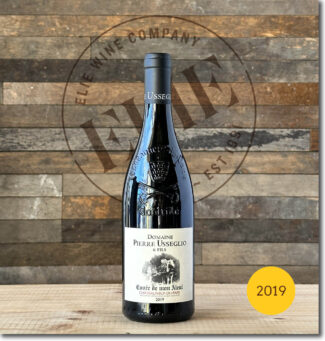 Domaine Pierre Usseglio & Fils ‘Cuvée de Mon Aïeul’, 2019 Châteauneuf-du-Pape ($126)
Domaine Pierre Usseglio & Fils ‘Cuvée de Mon Aïeul’, 2019 Châteauneuf-du-Pape ($126)
Full-bodied, lusciously textured and round, showing upfront notes of Asian spice, cocoa, and mint with a palate loaded with blackberry, kirsch and raspberry behind a granite-shale minerality.
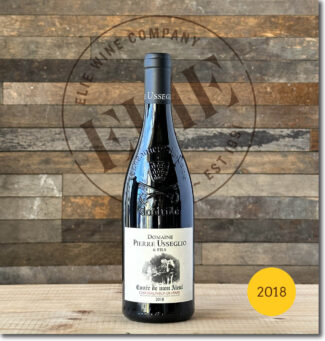 Domaine Pierre Usseglio & Fils ‘Cuvée de Mon Aïeul’, 2018 Châteauneuf-du-Pape ($126)
Domaine Pierre Usseglio & Fils ‘Cuvée de Mon Aïeul’, 2018 Châteauneuf-du-Pape ($126)
All whole-cluster Grenache aged in used demi-muids; the wine displays waves of ripe raspberries and black cherries drizzled with dark chocolate and spice. As usual, this cuvée comes from older vines in the La Crau, La Guigasse, and Les Serres lieux-dits, which are a mix of more pebbly and sandy soils. It ratchets up the intensity over the classic cuvée yet stays beautifully balanced with weightless texture, a great mid-palate, and a blockbuster of a finish.
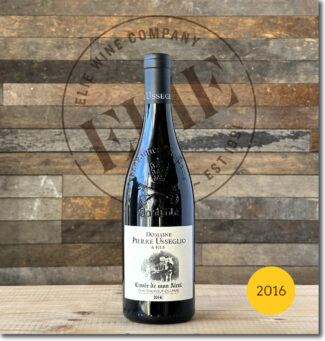 Domaine Pierre Usseglio & Fils ‘Cuvée de Mon Aïeul’, 2016 Châteauneuf-du-Pape ($126)
Domaine Pierre Usseglio & Fils ‘Cuvée de Mon Aïeul’, 2016 Châteauneuf-du-Pape ($126)
From one of the best growing seasons in recent history; the savory, mature flavors are just beginning to shine through. The years have added weight and gravitas to the wine; it shows voluptuous black fig and boysenberry preserves while retaining elegance and freshness with black and red fruit flavors intensely concentrated.
Réserve des 2 Frères
Domaine Pierre Usseglio Réserve des Deux Frères made its debut with the 2000 vintage. The name was changed to ‘Réserve des 2 Frères’ in 2007 along with a label redesign.
The wine is made from the estate’s oldest Grenache vines. Previously made with 10% Syrah, this only rarely the case today, although a small percent of Syrah went into vintage 2020. Grapes are usually completely destemmed; the level of stem retention depends on the vintage.
Slightly more modern in style than the tradition-heavy ‘grandfather’ wine ‘Mon Aïeul, ‘Two Brothers’ is aged in a combination of 10% new demi-muids and 10% new oak barrels along with a combination of one- or two-year-old French oak barrels, where it ages for 12-20 months. Domaine Pierre Usseglio Reserve des 2 Frères is not made every year, and when it is, only 500 cases are produced.
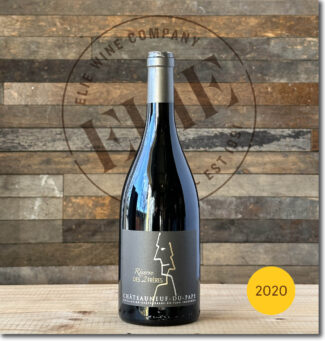 Domaine Pierre Usseglio & Fils ‘Réserve des 2 Frères’, 2020 Châteauneuf-du-Pape ($180) Pre-order
Domaine Pierre Usseglio & Fils ‘Réserve des 2 Frères’, 2020 Châteauneuf-du-Pape ($180) Pre-order
A splash of Syrah in the 2020 bottling leads to a fresh and focused wine, balanced, toasty and loaded with raspberry liqueur, crème de cassis, graphite, smoke meats, licorice that combines power and elegance.
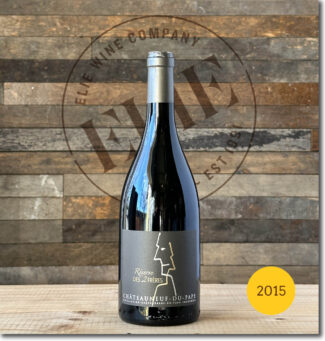 Domaine Pierre Usseglio & Fils ‘Réserve des 2 Frères’, 2015 Châteauneuf-du-Pape ($207)
Domaine Pierre Usseglio & Fils ‘Réserve des 2 Frères’, 2015 Châteauneuf-du-Pape ($207)
Grenache (per se) is not always the best candidate for aging; it possesses a naturally low concentration of phenolics, which contribute to its pale color and lack of extract. With a propensity for oxidation, Grenache-based wines tend to be made for early consumption.
But in Châteauneuf-du-Pape, under the hands of skillful viticulture and planted in marginal soil with restricted yields, all that changes. The vibrant fruit of young Grenache mellows and spice box tones come out with leather, and in this wine, tar, black olives and tobacco.
Châteauneuf-du-Pape Blanc
White Châteauneuf seems both an oxymoron and a paradox—not only does the warm Mediterranean climate of Southern Rhône seem far more suited to blustery reds, the grapes that make up the region’s white counterpart (Grenache Blanc, Roussanne, Bourboulenc and Clairette and to a lesser extent, Clairette Rosé, Grenache Gris, Picardin, Picpoul Blanc and Picpoul Gris) are not notably aromatic or high in acid. Yet, by preventing secondary malolactic fermentation, the acids are retained and the scents and synergy of the final wine exemplifies Provençal gardens, displaying heady floral notes with crisp, juicy peach and apricot.
Not only that, but they are often more consistent in quality than the reds and can reward long cellaring with remarkable results.
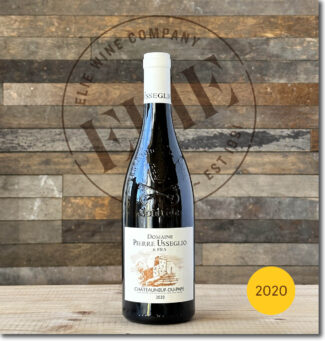 Domaine Pierre Usseglio & Fils, 2020 Châteauneuf-du-Pape Blanc ($67)
Domaine Pierre Usseglio & Fils, 2020 Châteauneuf-du-Pape Blanc ($67)
2.5 Acres is used in the production. A blend of 70% Clairette, 25% Grenache Blanc and 5% Bourboulenc, fermented and matured in a mix of vessels including stainless steel, barrels and amphorae. Fragrant and youthful with a wonderful salinity below flavors of white peach, pears and apples with some pronounced flintiness; the wine has excellent grip and bold extract with multiple layers that continue through a long finish.
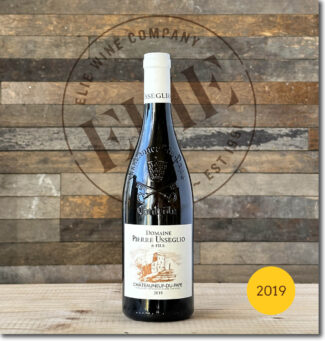 Domaine Pierre Usseglio & Fils, 2019 Châteauneuf-du-Pape Blanc ($55)
Domaine Pierre Usseglio & Fils, 2019 Châteauneuf-du-Pape Blanc ($55)
Usseglio’s 2019 Châteauneuf-du-Pape Blanc is a blend of 70% Clairette, 25% Grenache Blanc and 5% Bourboulenc, most of which was fermented and matured in stainless steel. Twenty percent barrel-fermentation adds just a touch of honeyed richness to the pineapple and tangerine flavors in this full-bodied effort; crushed citrus peel, salty minerality and hints of white peach emerges en route to a long, silky finish.
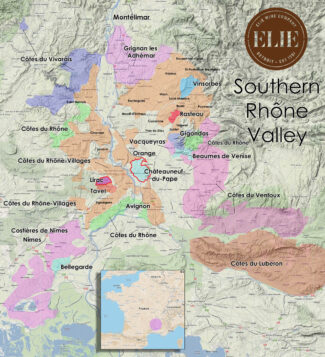
Lirac
A Short Hop Across The River From Châteauneuf-du-Pape
On the western side of the Rhône River, about six miles north of Avignon, Lirac is a typically Mediterranean wine growing cru, with low yearly rainfall and high sunshine levels (especially during summer and into the harvest months). The famous Mistral wind from the north plays a significant cooling role, and blows, on average, 180 days a year.
Lirac terroir is largely built around elevation; vineyards on the upper terraces of the appellation are made up of red clay and the large pebbles known as ‘terrasses villafranchiennes’, with the soil of the lower vineyards gradually showing more loess and/or clay-limestone. All are prone to summer drought and, under certain strictures, irrigation is allowed.
“The terroir of Lirac is often hidden in the shadows of Châteauneuf-du-Pape,” says Laure Poisson of Les Vignerons de Tavel & Lirac. “But in recent years, Lirac has emerged from the shadows to become something different, something unique.”
Blend makeup in Lirac wines is reasonably focused, with regulations favoring the classic Grenache, Syrah, Mourvèdre (and a bit of Cinsault) blend. Grenache must make up a minimum of 40% of the blend while Syrah and Mourvedre must be over or equal to 25%.
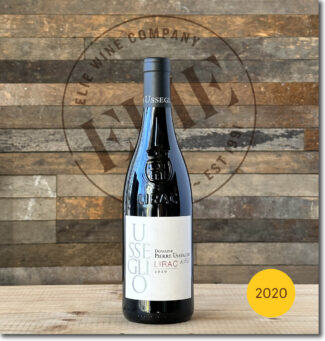 Domaine Pierre Usseglio & Fils, 2020 Lirac ($33)
Domaine Pierre Usseglio & Fils, 2020 Lirac ($33)
Usseglio & Fils’ 2020 Lirac is produced with 50% Grenache, 25% Mourvèdre, 20% Syrah from vines averaging 40 years old. A sweet core of blackberry is enshrouded in notes of black plum, black currant, aniseed and traces of new leather which lend promise to a cellar-worthy gem.
Famille Pierre Usseglio
L’Unique
Greater Than The Sum of Its Parts
The purpose of inventing the ‘Vin de France’ appellation was purely commercial; for a country whose wines are so inextricably linked to place of origin, a category that allows grapes from anywhere in the country to be used may seem like an odd innovation. But, faced with competition from elsewhere, it allowed winemakers to create a lower-priced product that could compete with New World wines. And, as is the case in a nation of vignerons, VdF wines are (for the most part) of self-evident quality, with many approachable, easy-to-understand prizewinners.
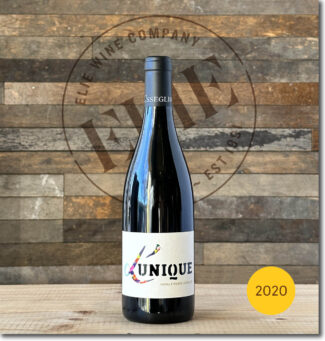 Famille Pierre Usseglio ‘L’Unique’, (2020) Vin de France ($25)
Famille Pierre Usseglio ‘L’Unique’, (2020) Vin de France ($25)
The spirit of VdF is loud and clear from the playful label on this blend of Grenache (40%), Syrah (20%), Mourvèdre (20%), Marselan (15%) and Merlot (5%) macerated for 25 days followed by six months aging in concrete before release. The wine is ripe and fruit-forward with fresh red berries, spring flowers and light spices. Very much an everyday wine that proves the Usseglio clan’s deft hand with all strata of winemaking, even in the level playing field that VdF encourages.
Vintage Journal
2020 Châteauneuf-du-Pape
Following the extreme heat of 2019, growers were hoping for plenty of rainfall over the winter to replenish aquafers, and they got it. An astonishing 15 -20 inches of rain fell between October and December, and a mild early spring saw vine buds break nearly two weeks earlier than in 2019. The summer was hot, but not unreasonably so; rains were moderate and frequent enough to prevent heat stress. Harvest for white grapes began in the third week of August, and the 2020 vintage is extremely strong in this category, however small (only 5% of Châteauneuf-du-Pape’s total). It is characterized by elegance and beauty, with a nose marked by citrus and stone fruit and a palate that combines balanced acidity with a prolonged finish.
2019 Châteauneuf-du-Pape
Grenache, however, enjoyed a marvelous renaissance in 2019, and for this sun, heat and wind-loving variety, the vintage was ideal. An abundant fruit set was followed by three heat waves interspersed with rain and more moderate temperatures, and as a result, there was no stress for the vines and ripening never shut down. Growers were able to pick at optimum ripeness and nothing much had to be done in the vineyard. The fruit’s health carried through to the cellar, with many growers reporting that their vinification were fast and efficient.
2018 Châteauneuf-du-Pape
The quintessence of a year that the old winemaker’s cliché refers to ‘a vintage made in the vineyard’—based on the difficulty that growers had bringing in the harvest. Rains in May and June created a poor fruit set for Grenache, and the threat of mildew was redoubled by the failure of the mistral; a rare occurrence in Châteauneuf-du-Pape. Humidity skyrocketed, making 2018 the dampest year since 1973, and organic farmers grew frustrated that natural treatments were washed away by un-forecasted rain. The result was a harvest that in particular showed a 40%-60% reduction in Grenache. Syrah and Mourvèdre fared better, and these varieties tend to be more pronounced in the blends.
2016 Châteauneuf-du-Pape
The 2016 vintage in Rhône was dominated by warm days and cool nights; ideal conditions for growing top-shelf Cinsault, Mourvèdre, Grenache and Syrah. Preceded by a relatively mild winter, the spring was dry and cool and summer exploded with plenty of sunshine and heat. September rains replenished the reservoirs enough to allow each variety to reach full phenolic ripeness. Harvest began in mid-September and, depending on vine age and terroir, some growers continued grape picking until early October. Châteauneuf red wines from this vintage are creamy and concentrated with silken texture and brilliant fruity richness, while the whites, full-bodied richness, remarkable complexity and sensational freshness.
2015 Châteauneuf-du-Pape
Although the Châteauneuf-du-Pape’s 2015 vintage was slightly challenging for the slow-ripening Grenache, talented winemakers rose to the occasion by producing wines with superior tannins and ripe fruit if slightly higher levels of alcohol.
In early September, the entire Rhône Valley saw heavy rain, which favored the vines planted on free-draining sand and resulted in fresh fruit-forward flavors and expressive minerality. The best domains produced age-worthy wines with complex flavors and sumptuous textures.
Notebook …
Traditional and Modern Styles
Throughout much of its history, CdP provided a leathery foil to the potent and somewhat austere elegance of Bordeaux and the heady sensuousness of Burgundy. CdP is ‘southern wine’, filled with rustic complexity—brawny, earthy and beautiful. But as a business, all wine finds itself beholden to trends, since moving product is necessary to remain afloat. During the Dark Ages (roughly1990 through 2010—in part influenced by the preferences of powerful critic Robert Parker Jr.) much of Châteauneuf-du-Pape’s output became bandwagon wines, jammy and alcoholic, lacking structure and tannin, in the process becoming more polished than rustic and more lush than nuanced. For some, this was delightful; for others, it was a betrayal of heritage and terroir.
These days, a new generation of winemakers seem to have identified the problem and corrected it. Recent vintages have seen the re-emergence of the classic, balanced style Châteauneuf-du-Pape, albeit at slightly higher prices. A changing climate has also altered traditional blends, so that more Mourvèdre may be found in cuvées that were once nearly all Grenache. Mourvèdre tends to have less sugar and so, produces wine that is less alcoholic and jammy, adding back some of the herbal qualities once so highly prized in the appellation. But a return to old school technique has also helped; however, many of the wines in this offer were destemmed prior to crushing and were fermented on native yeast rather than cultured yeast.
Vineyard Management and Varieties
In 1936, the Institut National des Appellations l’Origine officially created the Châteauneuf-du-Pape appellation, with laws and rules that growers and vignerons were required to follow. It was agreed that the appellation would be created based primarily on terroir (and to a lesser extent, on geography) and includes vines planted in Châteauneuf-du-Pape and some areas of Orange, Courthézon, Sorgues and Bédarrides. 15 grape varieties are allowed in the appellation: Grenache, Syrah, Mourvèdre, Terret Noir, Counoise, Muscardin, Vaccarèse, Picardan, Cinsault, Clairette, Roussanne, Bourboulenc, Red Picpoul, White Grenache and White Picpoul. Vine density must not be less than 2,500 vines per hectare and cannot exceed 3,000 vines per hectare. Vines must be at least 4 years of age to be included in the wine. Machine harvesting is not allowed in Châteauneuf-du-Pape, so all growers must harvest 100% of their fruit by hand.
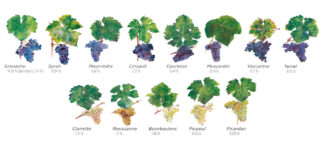
Beyond that, vines are allowed to be irrigated no more than twice a year. However, irrigation is only allowed when a vintage is clearly suffering due to a severe drought. If a property wishes to irrigate due to drought, they must apply for permission from the INAO, and any watering must take place before August 15.
Weather and Climate
Located within the Vaucluse department, Châteauneuf-du-Pape has a Mediterranean climate—the type found throughout much of France’s south—and characterized by hot, dry summers and cool, wet winters. It rarely snows at sea level (as opposed to the surrounding mountains, where snowfall may be considerable.)
As the equal of elevation and rainfall, a third defining feature of the climate in Southern France is the wind. In a land dominated by hills and valleys, it is always windy—so much so that in Provence, there are names for 32 individual winds that blow at various times of year, and from a multitude of directions. The easterly levant brings humidity from the Mediterranean while the southerly marin is a wet and cloudy wind from the Gulf. The mistral winds are the fiercest of all and may bring wind speeds exceeding 60 mph. This phenomenon, blowing in from the northeast, dries the air and disperses the clouds, eliminating viruses and excessive water after a rainfall, which prevents fungal diseases.
- - -
Posted on 2023.03.11 in Châteauneuf-du-Pape, France, Southern Rhone
Featured Wines
- Notebook: A’Boudt Town
- Saturday Sips Wines
- Saturday Sips Review Club
- The Champagne Society
- Wine-Aid Packages
Wine Regions
Grape Varieties
Albarino, Albarín Blanco, Albarín Tinto, Albillo, Aleatico, Aligote, Arbanne, Aubun, Barbarossa, barbera, Biancu Gentile, bourboulenc, Cabernet Franc, Caino, Caladoc, Calvi, Carcajolu-Neru, Carignan, Chablis, Chardonnay, Chasselas, Cinsault, Clairette, Corvina, Counoise, Dolcetto, Erbamat, Ferrol, Frappato, Friulano, Fromenteau, Gamay, Garnacha, Garnacha Tintorera, Gewurztraminer, Graciano, Grenache, Grenache Blanc, Groppello, Juan Garcia, Lambrusco, Loureira, Macabeo, Macabou, Malbec, Malvasia, Malvasia Nera, Marcelan, Marsanne, Marselan, Marzemino, Mondeuse, Montanaccia, Montònega, Morescola, Morescono, Moscatell, Muscat, Natural, Niellucciu, Parellada, Patrimonio, Pedro Ximénez, Petit Meslier, Petit Verdot, Pineau d'Aunis, Pinot Blanc, Pinot Gris, Pinot Meunier, Pinot Noir, Pouilly Fuisse, Pouilly Loche, Poulsard, Prieto Picudo, Riesling, Rondinella, Rose, Rousanne, Roussanne, Sagrantino, Sauvignon Blanc, Savignin, Sciacarellu, Semillon, Souson, Sparkling, Sumoll, Sylvaner, Syrah, Tannat, Tempranillo, Trebbiano, Trebbiano Valtenesi, Treixadura, Trousseau, Ugni Blanc, vaccarèse, Verdicchio, Vermentino, Xarel-loWines & Events by Date
- July 2024
- June 2024
- May 2024
- April 2024
- March 2024
- February 2024
- January 2024
- December 2023
- November 2023
- October 2023
- September 2023
- August 2023
- July 2023
- June 2023
- May 2023
- April 2023
- March 2023
- February 2023
- January 2023
- December 2022
- November 2022
- October 2022
- September 2022
- August 2022
- July 2022
- June 2022
- May 2022
- April 2022
- March 2022
- February 2022
- January 2022
- December 2021
- November 2021
- October 2021
- September 2021
- August 2021
- July 2021
- June 2021
- May 2021
- April 2021
- March 2021
- February 2021
- January 2021
- December 2020
- November 2020
- October 2020
- September 2020
- August 2020
- July 2020
- June 2020
- May 2020
- April 2020
- March 2020
- February 2020
- January 2020
- December 2019
- November 2019
- October 2019
- September 2019
- August 2019
- July 2019
- June 2019
- May 2019
- April 2019
- March 2019
- February 2019
- January 2019
- December 2018
- November 2018
- October 2018
- September 2018
- August 2018
- July 2018
- June 2018
- May 2018
- April 2018
- March 2018
- February 2018
- January 2018
- December 2017
- November 2017
- October 2017
- September 2017
- August 2017
- July 2017
- June 2017
- May 2017
- April 2017
- March 2017
- February 2017
- January 2017
- December 2016
- November 2016
- October 2016
- September 2016
- August 2016
- July 2016
- June 2016
- May 2016
- April 2016
- March 2016
- February 2016
- January 2016
- December 2015
- November 2015
- October 2015
- September 2015
- August 2015
- July 2015
- June 2015
- May 2015
- April 2015
- March 2015
- February 2015
- January 2015
- December 2014
- November 2014
- October 2014
- September 2014
- August 2014
- July 2014
- June 2014
- April 2014
- March 2014
- February 2014
- January 2014
- December 2013
- November 2013
- October 2013
- September 2013
- August 2013
- July 2013
- June 2013
- May 2013
- April 2013
- March 2013
- February 2013
- January 2013
- December 2012
- November 2012
- October 2012
Search



